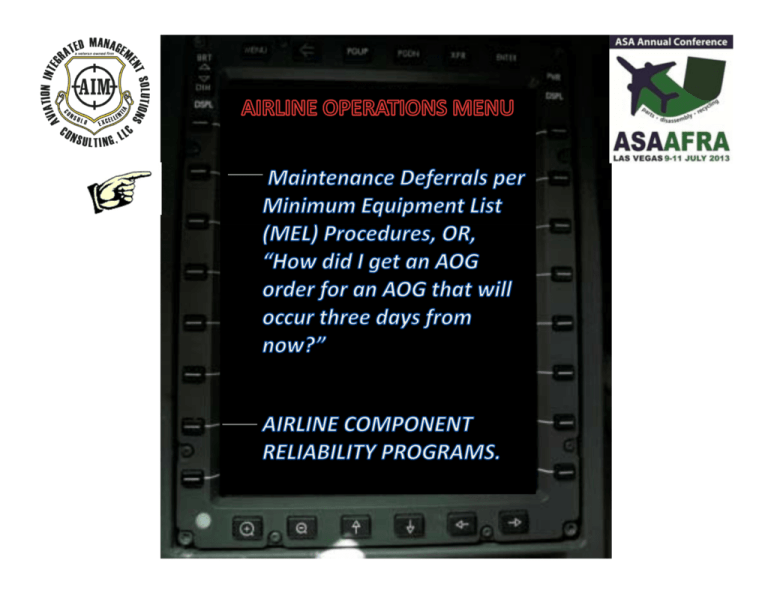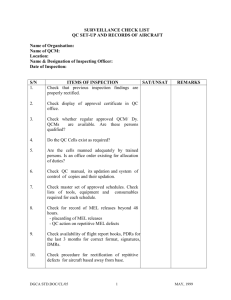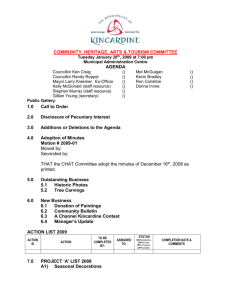A simple diagram of the process - Aviation Suppliers Association
advertisement

Actual Excerpt from an AFM, Aircraft Flight Manual, noting the applicable FAR, which is the basis for air carrier MEL procedures Air carrier MEL’s are derived from the FAA’s Master MEL. Below is a Preamble Excerpt from the FAA Master MEL A Master Minimum Equipment List (MMEL) is developed by the FAA, with participation by the aviation industry, to improve aircraft utilization and thereby provide more convenient and economic air transportation for the public. The FAA approved MMEL includes those items of equipment related to airworthiness and operating regulations and other items of equipment which the Administrator finds may be inoperative and yet maintain an acceptable level of safety by appropriate conditions and limitations; it does not contain obviously required items such as wings, flaps, and rudders. The MMEL is the basis for development of individual operator MELs which take into consideration the operator's particular aircraft equipment configuration and operational conditions. Operator MELs, for administrative control, may include items not contained in the MMEL; however, relief for administrative control items must be approved by the Administrator. An operator's MEL may differ in format from the MMEL, but cannot be less restrictive than the MMEL. The individual operator's MEL, when approved and authorized, permits operation of the aircraft with inoperative equipment. TOUR OF A TYPICAL FAA Master MEL PAGE ATA Chapter Repair Category. See slide How many does this aircraft have? How many will be required for the flight to continue? (M) symbol indicates a requirement for a specific maintenance procedure which must be accomplished prior to operation with the listed item inoperative. (O) symbol indicates a requirement for a specific operations procedure which must be accomplished in planning for and/or operating with the listed item inoperative. MEL Repair Category Intervals 24. Repair Category. All users of an MEL approved under parts 91K, 121, 125, 129, 135 and 142 must effect repairs of inoperative instrument and equipment items, deferred in accordance with the MEL, at or prior to the repair times established by the following letter designators. A. Repair Category A. This category item must be repaired within the time interval specified in the “Remarks or Exceptions” column of the aircraft operator’s approved MEL. For time intervals specified in “calendar days” or “flight days”, the day the malfunction was recorded in the aircraft maintenance record/logbook is excluded. For all other time intervals (i.e., flights, flight legs, cycles, hours, etc.), repair tracking begins at the point when the malfunction is deferred in accordance with the operator’s approved MEL. B. Repair Category B. This category item must be repaired within 3 consecutive calendar-days (72 hours) excluding the day the malfunction was recorded in the aircraft maintenance record/logbook. For example, if it were recorded at 10 a.m. on January 26th, the 3-day interval would begin at midnight the 26th and end at midnight the 29th. C. Repair Category C. This category item must be repaired within 10 consecutive calendar-days (240 hours) excluding the day the malfunction was recorded in the aircraft maintenance record/logbook. For example, if it were recorded at 10 a.m. on January 26th, the 10-day interval would begin at midnight the 26th and end at midnight February 5th. D. Repair Category D. This category item must be repaired within 120 consecutive calendardays (2880 hours) excluding the day the malfunction was recorded in the aircraft maintenance record/logbook. MEL Repair Category Intervals This is an Airline’s Approved MEL of the same system for the same aircraft. Note the differences: Repair Interval , No Maintenance actions , and where to place the placard TYPICAL MEL Deferral Scenario STEP 1: Aircrew becomes aware of a fault TYPICAL MEL Deferral Scenario STEP 2: Aircrew Writes it up in the logbook TYPICAL MEL Deferral Scenario STEP 3: Maintenance is dispatched to troubleshoot the fault. During the troubleshooting process it is decided to defer the write‐up because there is not enough time before the next flight, and further, the part is not in stock TYPICAL MEL Deferral Scenario STEP 4: The Airline’s Maintenance Operations Center issues the MEL Deferral control number for tracking and follow‐up TYPICAL MEL Deferral Scenario Excerpt from FAA MMEL Guidance: “23. Placarding. Each inoperative instrument or equipment item must be placarded to inform and remind the crewmembers and maintenance personnel of the item condition. To the extent practical, placards should be located adjacent to the control or indicator for the item affected; however, unless otherwise specified (i.e. AFM), placard wording and location will be determined by the aircraft operator.” TYPICAL MEL Deferral Scenario STEP 5: Placard the equipment TYPICAL MEL Deferral Scenario STEP 6: Issue a Placard for the logbook for visibility by subsequent aircrews. Note the control number issued by the Maintenance Operations Center Logbooks, when contained in metal covers are loosely called “Cans” TYPICAL MEL Deferral Scenario Behind the scenes, the AOG desk of the Maintenance Operations Center tries to locate the part which is not in stock. It’s options: • Cannibalize a part from another aircraft • Borrow or lease the part from an airline pool • Issue a Purchase order for a part TYPICAL MEL Deferral Scenario Now you, the distributor gets the PO and the call for the AOG due in three days A Recent actual MEL Deferral “Right Landing Light Out” in logbook. Note MEL Reference for deferral A Recent actual MEL Deferral It also is entered on the logbook’s index so subsequent flight crews can have a quick reference of what’s open. For this airline, note the “Ticket Number” which acts as a unique control number A Recent actual MEL Deferral A simple decal is affixed further apprising the aircrew of a defective system that has been deferred. Note the same “Ticket Number” NOTE: Rates of deferrals are closely monitored! Major Airline Sample: Not unexpectedly, the trend is towards electronic logbooks which would also contain provisions for Deferrals as shown By the way, you know the weather is creating havoc in the system when you get a text message like this: Before getting started, I’d like to make clear: Reliability Programs per se, are NOT an FAR requirement, but have developed over many years into best practices. Because of this, there are many variations as to how such practices are implemented by various air carriers. How may we define “Reliability”? From AC 120‐79: “Another desired result is that your aircraft operate with a level of reliability that is consistent with the goals of your maintenance program. “Reliability” is a broad term in this context and is an expression of dependability and the probability that an item, including an aircraft, engine, propeller, or component, will perform its required function under specified conditions without failure, for a specified period of time. Testing for effectiveness usually consists of collecting and analyzing operational performance data, such as: • • • • Maintenance‐related delays and cancellations, Failure rates of parts and components after they are approved for RTS, Discrepancy rates of aircraft after heavy maintenance, and Related trend analysis.” Although not required to do so, many airlines have their Reliability Programs incorporated within their CASS system. As reflected in AC 120‐79: “…if you do have an approved reliability program, you should incorporate it into your CASS as the means of performing operational data collection and analysis to monitor the effectiveness of your maintenance program.” Reliability Programs neatly feed and fit into the CASS System AC 120‐16: 1‐7. AIR CARRIER MAINTENANCE PROGRAM ELEMENTS. Your air carrier maintenance program includes the following 10 elements. FAR 121.373 — Continuing analysis and surveillance. (a) Each certificate holder shall establish and maintain a system for the continuing analysis and surveillance of the performance and effectiveness of its inspection program and the program covering other maintenance, preventive maintenance, and alterations and for the correction of any deficiency in those programs, regardless of whether those programs are carried out by the certificate holder or by another person. Many Larger air carriers have their Reliability Programs “Approved”. Such Approvals may take the form of an Operation Specifications Page on their Certificate Many Larger air carriers have their Reliability Programs “Approved”. Such Approvals may also take the form of an Approved Procedure. The FAA’s acceptance of the extent and depth of an air carrier’s Reliability Program appears to generally align with the expectations for CASS based on fleet size. (ref AC 120‐79) EVOLUTION OF RELIABILITY PROGRAMS THE FIRST GENERATION: HARD TIME: • Based on a belief that each functional part of a transport aircraft needed periodic disassembly inspection; i.e., an overhaul. • During this 1st generation, most major parts were “hard timed” Today, a smaller list of parts that are ‘hard timed’ include Engines and Landing gear EVOLUTION OF RELIABILITY PROGRAMS EVOLVING GENERATIONS: As the industry grew and evolved into more complex systems, the notion of so many parts requiring ‘hard time’ became mostly obsolete. ON CONDITION: • It requires that the part be periodically Inspected to determine if it can continue in service; it does not require overhaul to make this determination. Simple examples of ‘on‐condition’ parts include brakes and tires EVOLUTION OF RELIABILITY PROGRAMS EVOLVING GENERATIONS: The procedures for control of so many parts by either Hard Time or On‐Condition became awkward and burdensome, often inhibiting logical adjustment. To alleviate this situation, the FAA worked with the airlines to develop more responsive methods of controlling maintenance without sacrificing safety or FAA regulatory responsibility. This method of control was oriented toward mechanical performance rather than to predicting failure wear out points, as was the case in the previous methods. The new method was entitled “Reliability Control" because its major emphasis was toward maintaining failure rates below a predetermined value; i.e., an acceptable level of reliability CONDITION MONITORING: • Parts are neither ‘hard timed’ or ‘on‐condition’ as previously described. • Condition monitoring is accomplished by appropriate mean available to the operator for finding problem areas by monitoring performance and maintaining failure rates below an acceptable value or level of reliability. EVOLUTION OF RELIABILITY PROGRAMS An early cornerstone, but still referenced document is FAA AC 120‐17 EVOLUTION OF RELIABILITY PROGRAMS Another early contributor to the development of modern Reliability Systems. Note the term “Reliability‐ Centered Maintenance” EVOLUTION OF RELIABILITY PROGRAMS Another early contributor with profound effects on how maintenance is performed including reliability, was the ATA’s MSG‐2 (revision at the time). MSG‐Maintenance Steering Group. A simple diagram of the process System for collecting KEY relevant operational data which may include: • • • Pilot Write‐ups Maintenance Write‐ups Delay and Cancellations Attributable to Maint. Effectiveness of Corrective Action is monitored Data is fed through “Alert Level” Filters Corrective Action is Implemented Issues which are over the alert level are flagged. The initial alert typically draws attention to an ATA Chapter being ‘Over Alert’. Action is triggered to drill down, typically using Root Cause Analysis Procedures A simple diagram of the process System for collecting KEY relevant operational data which may include: • • • Pilot Write‐ups Maintenance Write‐ups Delay and Cancellations Attributable to Maint. Effectiveness of Corrective Action is monitored Data is fed through “Alert Level” Filters Corrective Action is Implemented Issues which are over the alert level are flagged. The initial alert typically draws attention to an ATA Chapter being ‘Over Alert’. Action is triggered to drill down, typically using Root Cause Analysis Procedures A simple diagram of the process Depending on the scope of the ‘Alert’, a team may be assembled, or Process Owners may be tasked to investigate the circumstances as needed: • • • • • • Engineering The MRO entity The Manufacturer Line Maintenance Base Maintenance Suppliers Action is triggered to drill down, typically using Root Cause Analysis Procedures A simple diagram of the process Results of the analysis may yield causes such as, but not limited to: Depending on the scope of the ‘Alert’, a team may be assembled, or Process Owners may be tasked to investigate the circumstances as needed: • • • • • • Engineering The MRO entity The Manufacturer Line Maintenance Base Maintenance Suppliers Components being scheduled for removal for incorporation of AD’s or SB’s “Age” Issues New Software Issues Incorrect troubleshooting procedures Chronic or Rogue components or aircraft Training Issues Fault Isolation Manual (FIM) shortcomings Quality Issues Airline Manual excerpt 14.5. Performance Standards 14.5.1. The Performance Standard is the computed measure of acceptable performance for a component or aircraft system. The Reliability Program uses the following units of measure for systems and components: 14.5.1.1. Pilot Reports (PIREPs) and Maintenance Reports (MAREPs) ‐ Rate per 1000 flight hours. 14.5.1.2. Unscheduled Component Removals (UCR) ‐ Rate per 1000 flight hours. 14.5.1.3. Engine Shutdowns ‐ Rate per 1000 engine hours. Airline Manual excerpt (redacted) FH: EAL: IAW: Flight Hours Exceeding Alert Level In Accordance With A key to any successful Reliability System is to implement a statistically based formula which establishes the “Alert Level” Airline Manual excerpt 14.5. Performance Standards 14.5.2. PIREPs, MAREPs and UCRs for each ATA system have a computed Alert Level. 14.5.3. The Alert Level is the 6 month experienced average rate plus 1.50 times the standard deviation for that 6 months. A multiplier of 1.50 is used to desensitize the Alert Level so that a single random failure does not cause the Alert Level to be exceeded. 14.5.3.1. The Alert Level is expressed as follows: 14.5.3.1.1. Alert Level = Y x + s (DF) In which Y x = 6 month average; s = standard deviation for the 6 month period; DF = Desensitizing Factor = 1.5 14.5.4. Exceeding an Alert Level (EAL) indicates a problem in components or systems that have occurred at an excessive frequency and may indicate a possible problem. Pilot Reports = (PIREPs) Maintenance Reports = (MAREPs) Unscheduled Component Removals = (UCR) A key to any successful Reliability System is to implement a statistically based formula which establishes the “Alert Level” ALERT LEVELS CALCULATIONS There are several methods of calculation alert levels, all of them are well known as statistical error calculation. Main or most common are: 1. MEAN + 3 SD 2. MEAN + STANDARD DEVIATION OF MEANS + 3 SD 3. MEAN x 1,3 4. MEAN + 2 SD 5. Weibull Method “CALCULATION OF ALERT LEVELS FOR RELIABILITY “ Jan Amborski Institute of Aviation Warsaw, Poland Al. Krakowska 110/114, 02‐256 E‐mail: j_amborski@yahoo.com BY THE WAY: BY THE WAY: Mean Time Between Removals ‐ MTBR A performance figure calculated by dividing the total unit flying hours accrued in a period by the number of unit removals (scheduled plus unscheduled) that occurred during the same period. MTBR = ((Quantity Per Aircraft) multiplied by (Flight Hours)) divided by Total Removals (Unscheduled plus scheduled) MTR = ((TQA x FHL) / TRS) Mean Cycles Between Removals ‐ MCBR Similar to MTBR, but with cycles instead of hours. MCR = ((TQA x FCL) / TRS) Mean Time Between Unscheduled Removals ‐ MTBUR A performance figure calculated by dividing the total unit flying hours accrued in a period by the number of unit unscheduled removals that occurred during the same period. MTBUR = ((Quantity Per Aircraft) multiplied by (Flight Hours)) divided by Total Unscheduled Removals MTU = ((TQA x FHL) / CUC) Mean Cycles Between Unscheduled Removals ‐ MCBUR Similar to MTBUR, but with cycles instead of hours. MCU = ((TQA x FCL) / CUC) ATA SPEC 2000 Chapter 13 contains many more defined Reliability Metrics AIM Solutions Consulting’s Roy Resto is available to team with you on these and many more: • • • • • • • • • • • • • • • Roy Resto is fully profiled on linked in at www.linkedin.com/in/royresto Email: royresto@aol.com 414‐467‐3063 New Repair Station Startup or FAR 145 Repair Station application EASA Approval for Repair Station ASA‐100 Accreditation AS 9120/9110/9100 Accreditation Management of your responses to major bids, RFQ’s, RFP’s, Solicitations, contracts, and agreements New ODA startup Recruiting specialized talent Temporary staffing of Executive or Management positions Crisis Intervention: Self Disclosures, FAA Certificate in predicament, key customer audit resolution Auditing your suppliers Internal Auditing Performing Research Technical and/or Manual writing Project Management Training on a wide catalog of topics including, but not limited to: • ESD, Receiving Inspection, SUPS, Quality Standards, FAR’s, AC’s, Order’s, Power by the hour contracts, Elements of Traceability for surplus parts, Use of DAR’s for 8130‐3’s, Use of FAA form 8130‐3, Standardized industry language and definitions, human factors, Airline Economics, Life Limited Parts, Self Life, Use of PMA, Standard, and TSO Parts, BER, Drop Shipping, Direct Shipping, New parts certification, Tags, C of C’s, National Stock Numbers THANK YOU FOR ATTENDING!



